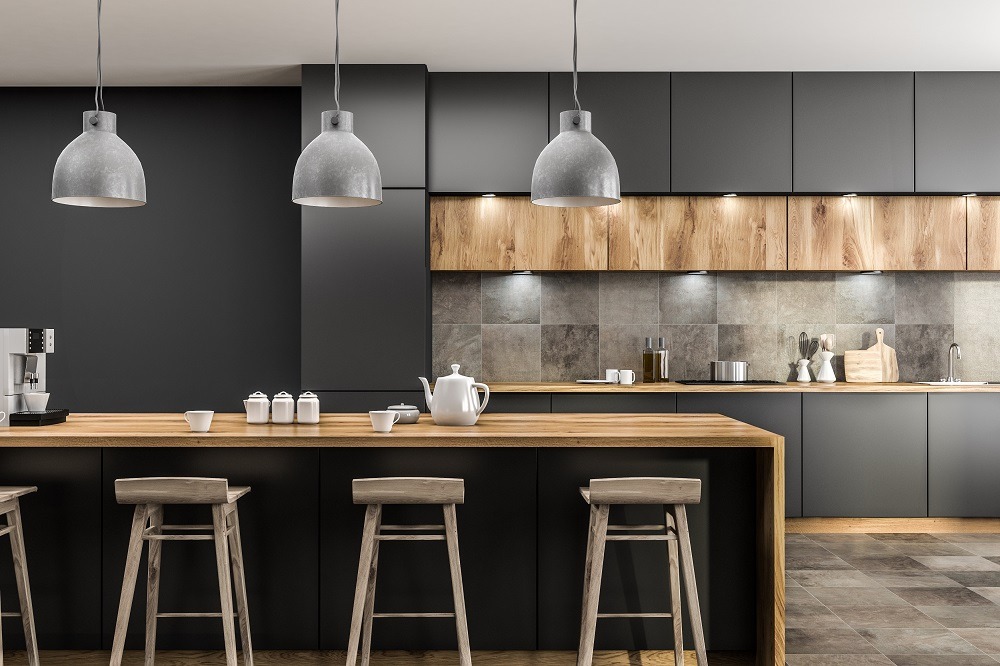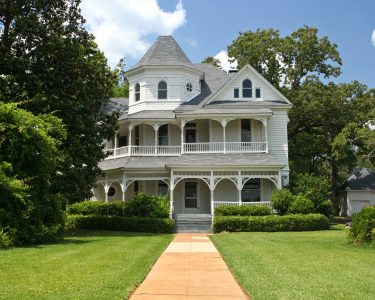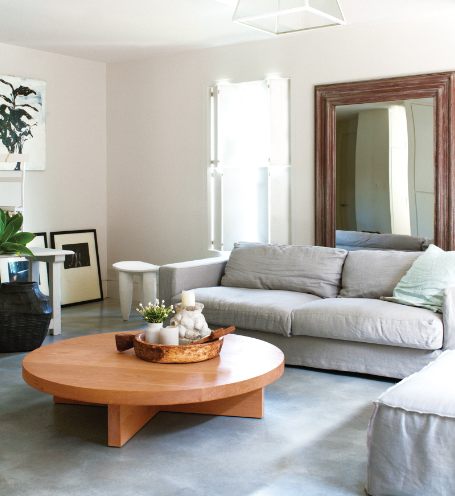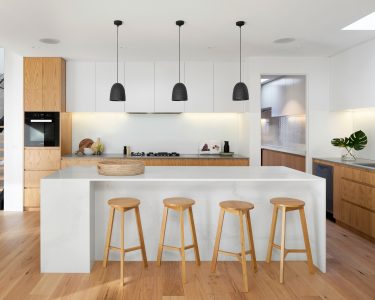Lighting has quite a significant impact on kitchen design. Kitchen lighting affects the functionality and overall vibe of the kitchen space. Whether preparing meals or entertaining guests, the right kitchen lighting can enhance the kitchen for every activity. In this article, we will discuss several types of kitchen lighting and how they add efficiency as well as aesthetic upgrades to your kitchen.
General Lighting
General lighting, also sometimes called ambient lighting, is the main source of illumination for the entire kitchen. It keeps the kitchen well-lit, which is important for keeping activities like cooking safe and comfortable.
Ceiling Fixtures
Ceiling-mounted fixtures are a popular choice for general lighting. This form of kitchen lighting is usually installed in the middle of the room, so it can distribute light evenly throughout your kitchen. Ceiling fixtures also make a practical solution to building codes requiring switch-controlled lighting in every room. They are effective in illuminating large areas but some smaller areas, like countertops, might need additional, more focused kitchen lighting. While ceiling lights don’t provide much focused lighting, they provide the general visibility and safety needed in every kitchen.
Task Lighting
Task lighting illuminates more specific areas where more detailed activities, like cooking and food preparation are performed. This type of kitchen lighting reduces shadows and boosts the visibility and precision needed for these activities.
Recessed Lighting
Recessed lights, or can lights, are installed flush with the ceiling, offering a lighting solution with a minimal profile. They are great for providing focused light on areas like countertops and kitchen islands. However, one disadvantage of recessed lighting is the potential for shadowing, which can occur when the light is blocked by cabinets or people. Modern recessed lighting fixtures are more energy-efficient and can be fitted with LED bulbs to reduce their energy needs. Recessed lights are a popular choice due to their low profile and versatility, despite the disadvantage of causing shadows.
Accent Lighting
Accent lighting adds visual interest and boosts the kitchen’s overall aesthetic appeal. It can draw attention to architectural features, decorative elements, and specific areas for a warm and inviting atmosphere.
Pendant Lighting
Pendant lights serve both functional and decorative purposes, providing focused illumination while serving as a stylish design element. These kitchen lights usually hang over kitchen islands, dining areas, or countertops. Pendant lights come in various styles, from modern to traditional, and can be used to accentuate the overall design of the kitchen. They provide great task lighting, especially when several pendants are combined to cover a larger area. Pendant lighting makes a popular choice for adding elegance and personality to your kitchen.
Specialty Lighting
Specialty lighting includes unique and innovative types of kitchen lighting meant to meet specific needs and preferences, adding character and functionality to the kitchen.
Under Cabinet Lighting
As the name would suggest, under cabinet lights are installed beneath kitchen cabinets to light up the countertops and work areas underneath. They are particularly useful for reducing shadows and providing bright, focused light for tasks such as chopping vegetables or reading recipes. LED strips and puck lights are common choices for this type of lighting because they’re energy efficient and easy to install without risking electrical safety.
Track Lighting
Track lighting refers to a series of adjustable light fixtures mounted on a track. This system allows flexibility in kitchen lighting arrangements, since the individual fixtures can be moved and directed to your needs. Track lighting is great for kitchens with unorthodox layouts or other forms of specific lighting requirements. With track lighting, you get the benefits of recessed lighting with the added advantage of adjustability. This combination makes it a versatile option for both general and task lighting. However, track lighting can sometimes be seen as visually intrusive, so you should be careful and consider whether it complements your kitchen’s design.
Trending Kitchen Lighting Ideas
Keeping up with current kitchen lighting trends can jump start ideas for innovative and stylish lighting solutions for your kitchen. Here are some of the current popular kitchen lighting trends:
Mixed Eras
Combining modern kitchen lighting with traditional elements is a growing trend currently. This approach mixes contemporary LEDs with classic silhouettes, creating fixtures that are unique and eye-catching. Mixed era lighting gives depth and character to your kitchen, adding timelessness and freshness.
Natural Materials
Incorporating natural materials like wood, stone, and metal into kitchen lighting fixtures is another popular interior design trend. Materials like this add warmth and texture to the kitchen, creating a cozy and inviting atmosphere. Wabi-sabi-inspired designs, which celebrate imperfections and organic shapes, are one particular trend these materials would work well for. Fixtures made from materials like teak and acacia wood add an earthy, artisanal touch to the kitchen.
Oversized Lighting
Bold, oversized lighting fixtures also create a unique look in modern kitchens. Large pendant lights or even chandeliers can serve as dramatic, visually interesting focal points. Be careful when using oversized fixtures though, they need to be positioned in the right ways to avoid obstructing views or becoming hazards.
Sustainable Lighting
Eco-friendly kitchen lighting options, like LED lights and sustainably made fixtures, are becoming increasingly popular. As mentioned above, LED lights are energy-efficient and long-lasting, so they don’t need to be replaced as frequently. Timber strip lights provide another great example, since they’re made from renewable wood sources, as do simple natural light from windows for a sunroom-like effect.
Layered Lighting
Combining different types of lighting—such as pendant lights, under cabinet lights, and recessed lights— into layers gives you more detailed control over the kitchen’s lighting levels. Layered lighting gives you more flexibility than just one of the types of kitchen lighting mentioned above. This way, you can change the kitchen’s ambiance to suit different activities and moods. For example, pendant lights can be used for intimate dining settings, while recessed lights illuminate surfaces for cooking and cleaning.
Choosing the Right Types of Kitchen Lighting
Choosing the right types of kitchen lighting involves finding a delicate balance between functionality and visual appeal. General lighting ensures the space is well-lit and safe, task lighting provides focused lighting for specific activities, and accent lighting adds visual interest and enhances the overall design. Specialty lighting solutions, such as under cabinet and track lighting, offer personalizable benefits you can tailor to your individual needs. By staying on top of current trends and mixing lighting types, you add beauty and practicality to your kitchen. With the right kitchen lighting, you can cook, dine, and entertain in a welcoming, efficient space.





